The sweet taste of Summer
Picture your summer vege garden bursting at the seams with colour, health and vitality. Picking armloads of fresh, sweet homegrown fruit and veges to feed family and friends is one of summer's greatest joys, but there’s no time to waste if we’re to make the most of the warm months ahead.
PLANT |
|
| 1 | November is a great month for planting a wide range of veges, but it’s an especially important time to plant those crops that need a good few months of warm temperatures for ripening; e.g. chillies, capsicums, eggplants, kumara and pumpkins. For a head start buy big seedlings in individual pots. |
| 2 | November is also an ideal month to plant tomatoes. Prepare the soil well with lots of compost. Set stakes firmly in the ground prior to planting. |
| 3 | Don’t plant tomatoes in the same soil as last year. If you cannot change the location, dig out the top 30cm of soil and replace it with soil that has not been used for tomatoes or any other member of the tomato family (potatoes, eggplant, and capsicum). Wherever possible practice crop rotation for all crops to prevent build-up of soil borne pests and diseases. A two or three year break is best. |
| 4 | Zucchini and flying saucer-shaped scallopini grow quickly with phenomenal yields. Modern compact varieties are ideal for smaller gardens, available in yellow and green for colour variety on the dinner plate. |
| 5 | Cucumbers are ready to pick within two months of planting. Pop a plant in every few weeks for a continous summer and autumn supply. |
| 6 | Pumpkins and melons need a full summer season to ripen so plant them as soon as possible after frost has passed. |
| 7 | While full sun is best for most vege plants, lettuces, parsley, rocket and coriander benefit from part day shade during the heat of summer. Rhubarb is another attractive plant that will grow in a shadier corner of the vege garden. |
SOW |
|
| 8 | Sweetcorn and beans grow fast from seed sown directly into well-drained crumbly garden soil that has warmed to 16°C for germination. |
| 9 | Mix in loads of compost before sowing seed. If you don’t have a teepee or frame for climbing beans, try dwarf beans. |
| 10 | When sowing large seeds such as sweetcorn, zucchini or beans, sow two seeds at each station, removing the weakest after germination. |
| 11 | Plant sweetcorn in a block rather than a single row for better pollination (hence fully formed cobs). |
| 12 | Root crops like carrots and beetroot are best sown directly into the garden and thinned out to make space as they grow. |
| 13 | Sow salad seeds in fortnightly batches for non-stop picking. |
PROTECT |
|
| 14 | Protect vulnerable young seedlings from slugs and snails. Read about this at www.gogardening.co.nz |
| 15 | Use netting over wire frames to keep seedlings safe from birds or rabbits. The same frames can be used for frost cloth if a late unseasonal frost is forecast. |
| 16 | If summer pests get the better of you, seek advice at your Go Gardening centre. Most sprays (natural or otherwise) will kill the good insects along with the bad, so the less you spray the less you will need to spray. Neem oil is a natural biodegradable spray that controls many pest insects and is believed to be non-toxic to beneficial insects. |
| 17 | Tomato and potato psyllid (TPP) is a major problem in some areas and difficult to detect before the damage is done. This pest can be controlled with Yates Mavrik, taking care to spray the entire leaf surface. |
MULCH |
|
| 18 | Great for all summer vege plants, mulching is the best way to keep moisture in the soil, where it is needed most. A good layer of organic mulch will also save you hours of weeding and enrich your soil as it rots down. |
| 19 | Useful materials include compost, bark, pine needles, leaves, and pea straw. Beware of products that may contain weed seeds. |
| 20 | As you trim herbs and shrubs, lay the prunings on the ground as mulch. |
| 21 | Pea straw placed around fruiting plants like cucumbers, strawberries, eggplants, and dwarf tomatoes keeps the fruit clean and dry. |
| 22 | Plastic weed mat is also used for this purpose. It is an effective weed barrier, and can help keep the soil warm, but lacks the advantage of improving the organic content of the soil. |
WATER |
|
| 23 | Though greatly assisted with the laying of a good mulch, watering gets more and more important as summer goes on. Always water after planting and before laying mulch. |
| 24 | Tomatoes and other fruiting plants need regular watering especially once the fruit appears. |
| 25 | Avoid watering in the middle of a hot day when evaporation is fast. If possible, water in the morning before the sun gets up. |
FEED |
|
| 26 | Rapid growth needs food to fuel it. Apply fertiliser at planting time or as a side dressing once crops start growing. To make it easy, there is a wide range of plant foods formulated for specific crops. |
| 27 | Once the fruit first appears plants need ample nutrients to support the best crops. Tomatoes respond well to fertiliser high in potassium. A homemade fertiliser made from comfrey leaves is ideal. |
| 28 | Organic fertilisers add humus as well as nutrients, helping to preserve the long-term health of your soil. |
| 29 | Fast-acting fertilisers (liquids, powders or granules) provide a quick boost when used as a supplement to compost and longer-term fertilisers. |
| 30 | Veges grown in containers need the most feeding. Use regular liquid feeding as a supplement to slow release fertilisers. |
PICK |
|
| 31 | Pick salad greens regularly to maintain fresh healthy growth. |
| 32 | Beans and zucchini taste best if picked when young and tender, and cooked the day they are picked, and frequent picking keeps them cropping for longer. |
| 33 | The shorter the time from picking to eating, the sweeter your sweetcorn will be. Cobs are ready when the silks turn dark brown. If you’re not sure, open the husk at the top and press a grain with your fingernail. If it is soft with a thick creamy juice it’s ready. |
| 34 | Chillies and sweet peppers can be picked at the green stage, but flavour and sweetness intensifies with maturity. The hotter the weather, the hotter the chilli! |
| 35 | Pumpkins and melons need a full summer to ripen. In cooler climates, look for quick maturing varieties. |
13-Dec-2013
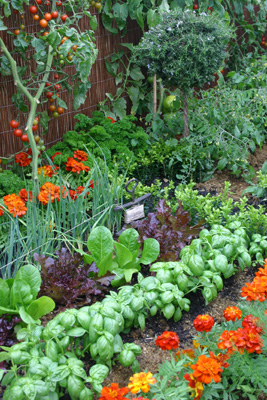
A summer vege garden can be as visually beautiful as it is productive. Make the most of all the different shades of green, blue and purple, and brightly coloured silver beet stems. Herbs and flowers planted for extra colour will also attract beneficial insects and help repel pests.
Archways, teepees and obelisks provide charming vertical accent. Add further character with pots, sculptures or seats. Bay trees and citrus trees make lovely centrepieces. However beware of creating too much shade.
While border hedges look very attractive, they do take a lot of space, and compete with veges for light, food and water. If you do have room for a little hedge, consider Chilean guava for its colourful and sweet late-summer berries. Or try an edible border of parsley, chives or thyme.
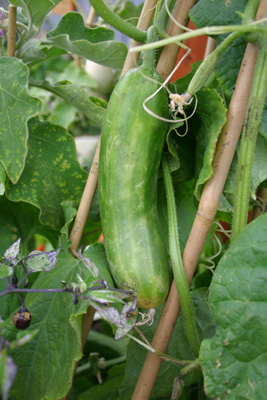
Cucumber
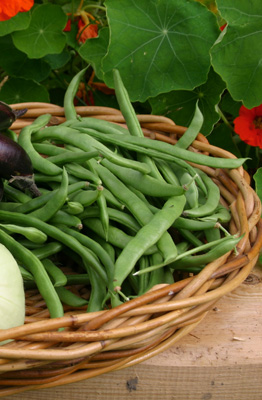
Beans
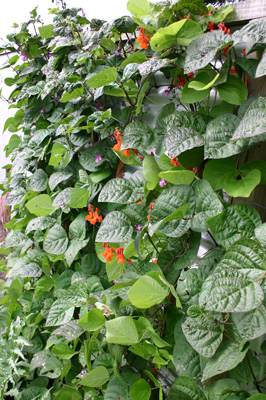
Climbing beans
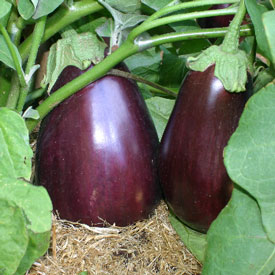
Egg Plant
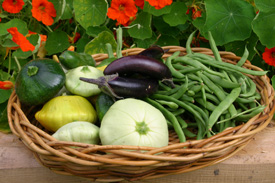
Summer harvest
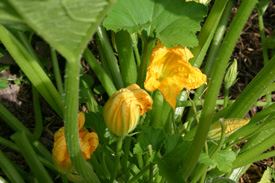
Zucchini in flower
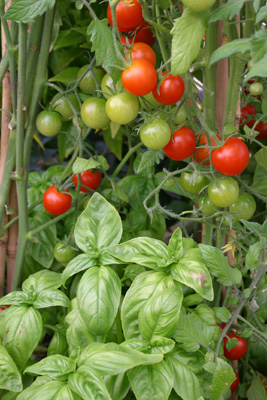
Tomatoes & basil


